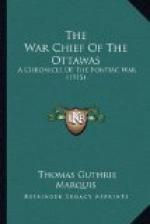There was, however, one British officer, at least, in America who did not hold such views towards the natives of the soil. Sir William Johnson, through his sympathy and generosity, had won the friendship of the Six Nations, the most courageous and the most cruel of the Indian tribes. [Footnote: For more about Sir William Johnson see The War Chief of the Six Nations in this Series.] It has been said by a recent writer that Johnson was ’as much Indian as white man.’ [Footnote: Lucas’s A History of Canada, 1763-1812, p. 58.] Nothing could be more misleading. Johnson was simply an enlightened Irishman of broad sympathies who could make himself at home in palace, hut, or wigwam. He was an astute diplomatist, capable of winning his point in controversy with the most learned and experienced legislators of the colonies, a successful military leader, a most successful trader; and there was probably no more progressive and scientific farmer in America. He had a cultivated mind; the orders he sent to London for books show that he was something of a scholar and in his leisure moments given to serious reading. His advice to the lords of trade regarding colonial affairs was that of a statesman. He fraternized with the Dutch settlers of his neighbourhood and with the Indians wherever he found them. At Detroit, in 1761, he entered into the spirit of the French settlers and joined with enthusiasm in their feasts and dances. He was one of those rare characters who can be all things to all men and yet keep an untarnished name. The Indians loved him as a firm friend, and his home was to them Liberty Hall. But for this man the Indian rising against British rule would have attained greater proportions. At the critical period he succeeded in keeping the Six Nations loyal, save for the Senecas. This was most important; for had the Six Nations joined in the war against the British, it is probable that not a fort west of Montreal would have remained standing. The line of communication between Albany and Oswego would have been cut, provisions and troops could not have been forwarded, and, inevitably, both Niagara and Detroit would have fallen.
But as it was, the Pontiac War proved serious enough. It extended as far north as Sault Ste Marie and as far south as the borders of South Carolina and Georgia. Detroit was cut off for months; the Indians drove the British from all other points on the Great Lakes west of Lake Ontario; for a time they triumphantly pushed their war-parties, plundering and burning and murdering, from the Mississippi to the frontiers of New York. During the year 1763 more British lives were lost in America than in the memorable year of 1759, the year of the siege of Quebec and the world-famous battle of the Plains of Abraham.
CHAPTER II
PONTIAC AND THE TRIBES OF THE HINTERLAND




